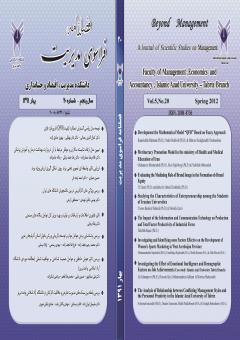-
-
List of Articles
-
Open Access Article
1 - Development the Mathematical Model “QFD” Based on Fuzzy Approach
Kamaledin Rahmani Nader Bahloli Behrooz Sadeg zadeh -
Open Access Article
2 - Meritocracy Promotion Model in the ministry of Health and Medical Education of Iran
Gholamreza Memarzadeh Reza Najaf beygi Yadollah Abbaszadeh -
Open Access Article
3 - Evaluating the Mediating Role of Brand Image in the Formation ob Brand Equity
Hossein Emari Ahmad Zende dell -
Open Access Article
4 - Studying the Characteristics of Enterpreneurship among the Students of Iranian Universities
Younes Baadavare Nahandi Moatafa Zaree -
Open Access Article
5 - The Impact of the Information and Communication Technology on Production and Total Factor Productivity of Industrial Firms
Yadollah Rajaye -
Open Access Article
6 - Investigating and Identifying some Factors Effective on the Development of Women's Sports Marketing in West Azerbaijan Province
Mohammad rahim Najaf zadeh Farkh lega Njafzadeh Mehdi Rostami Jhela Morseli -
Open Access Article
7 - Investigating the Effect of Emotional Intelligence and Demographic Factors on Job Achievements (Case study: Islamic Azad University Tabriz Branch)
Ali Salman pour Hossein Aliye Mohammadreza Afgham Morteza Shokrzadeh -
Open Access Article
8 - The Analysis of Relationship between Conflicting Management Styles and the Personnel Preativity in the Islamic Azad University of Tabriz
Soleyman Iranzadeh Gader Zemestani Mehdi Pakdel Bonab Sadegh Babaye heravi
-
The rights to this website are owned by the Raimag Press Management System.
Copyright © 2021-2025







